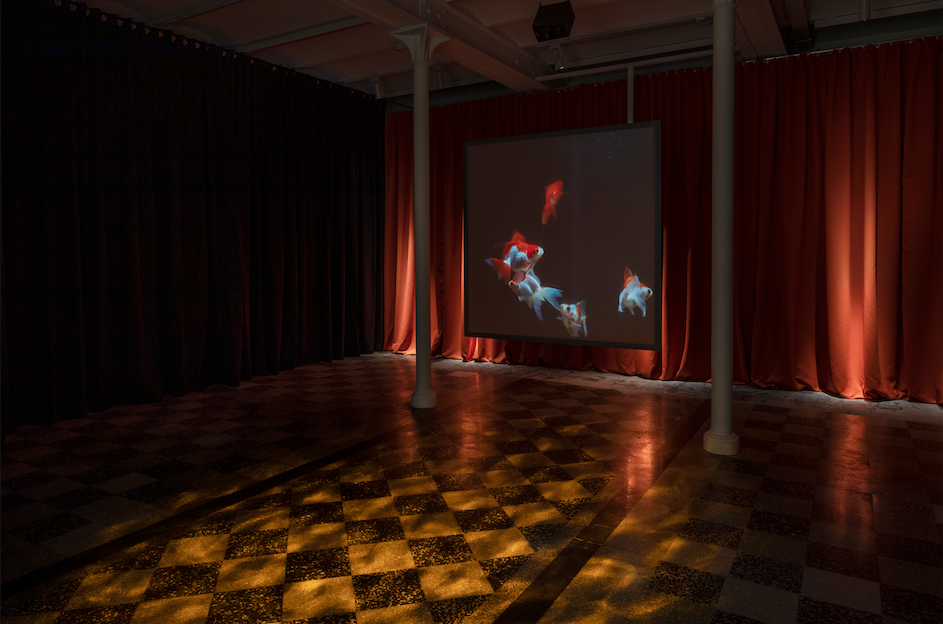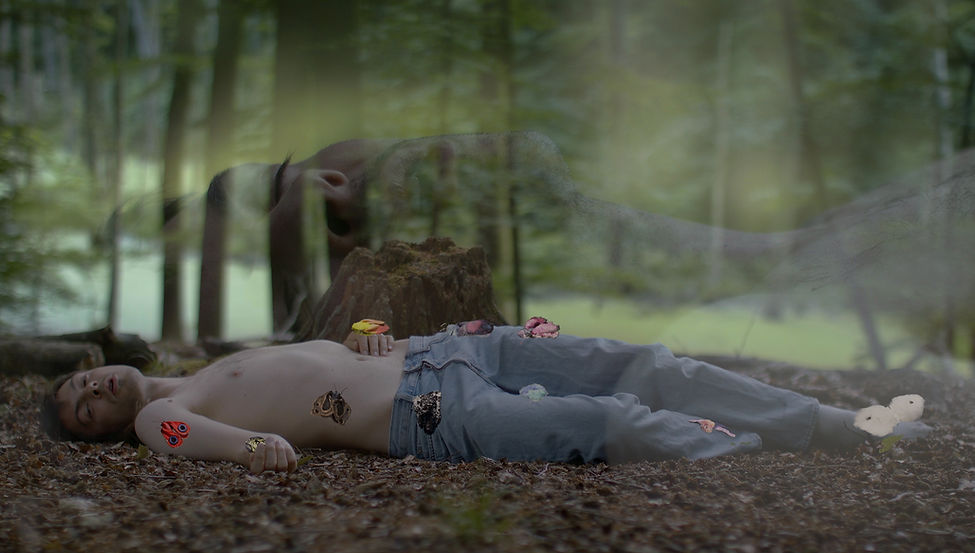





NOVEMBER 27 2020 - MAY 16 2021
A heavy-metal hymn oozing contemporary doomsday apocalypse with a twist.
by curator Aukje Lepoutre Ravn
In his first major solo show – Lilith Grotto – Kim Richard Adler Mejdahl, cross-disciplinary artist and musician, presents seven new works of video, sculpture, installation, and interactive animation. With equal parts of dark humour, poetry, and absurd horror, Mejdahl transforms the entire ground floor of Overgaden into a disconcerting, gothic world of magic mirrors; an underworld where Christian codes are scrutinised and related to the innate brutality of nature and where the role of audience members as co-producers is central.
Entitled Lilith Grotto Mejdahl sets the tone by combining several conflicting religious references, playing on both life and death. Lilith, a name reputedly deriving from the flower lily, was a Jewish biblical figure later demonized by the Christian church. In many cultures, the grotto is a holy place, worshipped as a natural altar. It is a female metaphor and the ultimate symbol of the uterus. In Western funeral rites the lily flower is associated with human mortality, by functioning as a symbol of spiritual rebirth. Finally, ‘Lilith Grotto’ was the name of one of the largest Satanic churches in the USA during the 1960s.
Staged as a dark and convoluted cave, Lilith Grotto combines images of volcanic apocalyptic scenarios, witchy rituals, and the destruction of Christian symbols with musical instruments, animated fantasy creatures, and a poetic music video (Hour of Moth) in which the artist, in a sensual voice, invokes the transforming powers of light to mirror the desire of moths.
The exhibition incorporates several musical elements, inviting visitors to use their voices and bodies to create pictorial motifs, sounds, and songs. The visual expression of the works Doomsdaydrummer and Orallyn is defined directly by auditive audience interaction while the sculptural installation Psalm Machine is a cocoon-like string instrument played by inserting small balls into the instrument. Mejdahl wants to make the audience musical co-creators of the sound and afterlife of the exhibition. Hence, all sound generated by the audience is recorded and subsequently carefully put together by the artist and released as a new major collective musical piece.
Contrasting the omnipresent contemporary discourse on climate crisis and Anthropocene guilt, Lilith Grotto can be viewed as a piece of eco-gothic horror where the notion of embracing the monstrous essence of nature is praised as the key to a sustainable communal future. The eco-gothic philosophy examines the construction of the complex gothic body as inhuman, non-human, trans-human, post-human, or hybrid, asking how it can be more meaningfully interpreted as a starting point for new environmental and species-related identities. In continuation of this, Lilith Grotto plays with the idea that we are teetering on the threshold of a new and radically changed understanding of nature; an understanding where humans, powerless in the face of the untameable and menacing nature, discovers a redeeming possibility of entering into a new, collective covenant that allows us to unite with the maternal monstrosity of nature.







%20(2020)_still.jpg)

%20(2020)_still.jpg)

Review in Poltiken
"Det er et brag af en udstilling [...] et projekt, der peger langt ind i den kunstneriske fremtid.
Det er en mere magisk og mindre idyllisk natur, Mejdahl lader os træde ind i. Det er den slags natur, hvor kroppen bliver til muld, og bjerge styrter sammen under deres egen vægt."
Review in kunsten.nu
"Liljegrotten er et sammensat totalværk med tre skildrende etuder (videoinstallationer) og tre instrumenter, der tilsammen stykker en animeret apokalypse sammen – og vi er indbudt til at indtage rollen som medspiller.
Eller det vil sige, at vi skal spille og synge med i kunstnerens kult-dødsband."
Review in Weekendavisen
"En både horrormørk, gakket og surrel rejse."




One dark and stormy night, I stumbled across a quote by Antonio Gramsci, which detonated a hydrogen bomb inside my head: “The old world is dying, and the new world struggles to be born: now is the time of monsters.”ª
personal text by Kim Richard Adler Mejdahl from Lilith Grotto catalogue


Let's talk about monsters. Litterally, but also as a moral conceptualization of something that is inhumane and incomprehensible – the uncompromising. Monsters, as archetypes of certain vulnerabilities or like clues to the fears and fascinations of a particular time. Monsters, as containers of human features the we need to externalize in order to overcome. I dream of creating a new monster archetype. I sense that this new creature should symbolize the mercilessness of the climate crisis and our own destructive features, but I neep some help. I'm sick and tired of doing all the work alone, being an artist. I've been wondering if there's a degree of fascination lurking beneath all of this climate change fear. That we are, all at once, scared shitless and fascinated by watching things go up in flames? The glow of fire in people's wide-open eyes...one keeps staring until the entire jungle has been eaten up by the flames.
Allow me to pull out of my pocket a tiny philosopher (her name is Brenda, btw), and she says (with a fag hanging ouf of her mouth) that is's all about an apocalyptic fascination, darling, and it's rooted in Christianity. You can be a non-believer, and still the thought of apocalypse is concealed in our cultural entrails. Now let's spice it all up with some hallmarks of modernity, namely the instrumentalization and industrialization of nature. The industry says: ”You're not a tree that breathes, valuable in your own right, you're kitchen drawers!” The priest says: ”Nature is secular and not God.” The Factory and The Church has sucked the soul out of nature, but now there are forces that seem to turn against us because we don't respect them. Our times call for a new monster! One through which we can examine our new inner landscape, our changing world, our new fears, and our new longings.
The fear of climate change will radically change our mental view of nature. Isn't nature, shaped by climate changes, gradually assuming monstrous features? Deformed, uninhabitable, unpredictable, unnatural – a destructive entity kindling a cosmic fear? Will nature no longer need saving (victim) but need overcoming (enemy?). It all feels a bit diabolic, doesn't it? Charred koala bears.
The witch is back, because her qualitites quench present-day longings for connectedness with nature and she pinpoints the pain we feel caused by the loss of control. The witch understands nature, and she's connected to it in a sensual way, but nowadays she's potrayed a little too squeaky clean. I don't want a blogger witch with purple hair and matcha tea; I want an evil bitch with sharp yellow teeth who steals your baby from its craddle. She's the one in tune with nature; not the Starbucks witch. Then there's the sense of control that evaporates before our eyes, but indeed characterizes the witch: She makes magic. In religion, one submits to a god -- you pray, and you worship. Magic, on the other hand, ”captures” the god, and one achieves metaphysical command of a hidden world. In short, the witch simply incarnates big dick enegy.
Let me talk a bit about the the name Lilith Grotto, because it touches me. Lilith Grotto was one of the biggest Satanic churches in New York City during the sixties named after a Jewish demon witch. Her name reputedly derives from the flower lily. Now, imagine a twisting pitch-black stalactite cave where lilies grow without any sunlight (Maybe they are glowing in the dark in green ghost mint – these beautiful, poisonous funeral flowers). I can't imagine a more maternal symbolism than a grotto, a stony uterus.The name unites femininity and aggression. Brutality and destruction are not, by definition, masculine. I dream of creating a magic place for seances, where one enters as the receiver and exits as the messenger; where the seance, the collective act, becomes a shared cocoon where we undergo transformation together. Oh God, here I go, sounding so self-important. I just want you to enter the cave and make some music together, god dammit.
In some parts of the world the cave is a holy place, it's a natural altar. What should we worship there, and what does it sound like? Let's imagine a hymn with verses that go like steps, not the gates of heaven, but down to the basement below where all the monsters live. Satanists worship Christian sins as virtues, opting for satisfaction rather than abstinence. They want ”vital existence” rather than spiritual wishful thinking (self-delusion), and they refuse to give up life for a god, seeing it as a lame death wish. Satanists think of nature as having instrinsic value, and they're not afraid of the monster of Christianity.
Is there something to be gained here? Especially if we allow satisfaction to become a common trait, a question of nature and not just a question of individual satisfaction? Maybe our hymns would be hymns for the koala bears, the trees, the moths. Would it sound like heavy metal? White noise? Like cackling witches? Dissonance? Harmony?
One morning (a bright and sunny one) I head a voice coming out of my television: ”Nature wants to de-temple the munk and make him ready for the future.” It was Jonathan Meese describing the painting 'The Munk by the Sea' by Caspar David Friedrich. If this exhibition has one purpose, that must be it: de-templing. The word nature I will never fully understand, just like the word art. They are magic words made of glass, where light shines through the letters and throws changing images on the walls. The words are related.






Liljegrotten (Lilith Grotto) is produced by: Overgaden
Installation shots by Anders Sune Berg
Still images by Kim Richard Adler Mejdahl
Financially supported by Aage og Johanne Louis-Hansen Fonden, Statens Kunstfond, and 15. Juni Fonden
Kim Richard Adler Mejdahl would like to say a huge thank you for the kindest help and support to
Henriette Sennenvaldt, SØS Gunver Ryberg, Tori Wrånes, Dark Matters Studio, Christina Wilson, Morten Jensen,
Anna Dea Djuraas, and Line Finderup Jensen
Extra special thank you to George Koutsouris and Simon Reinhardt for their extreme effort
Biggest explosion of confetti and thank you to all the generous people at Overgaden, who made this exhibition possible

